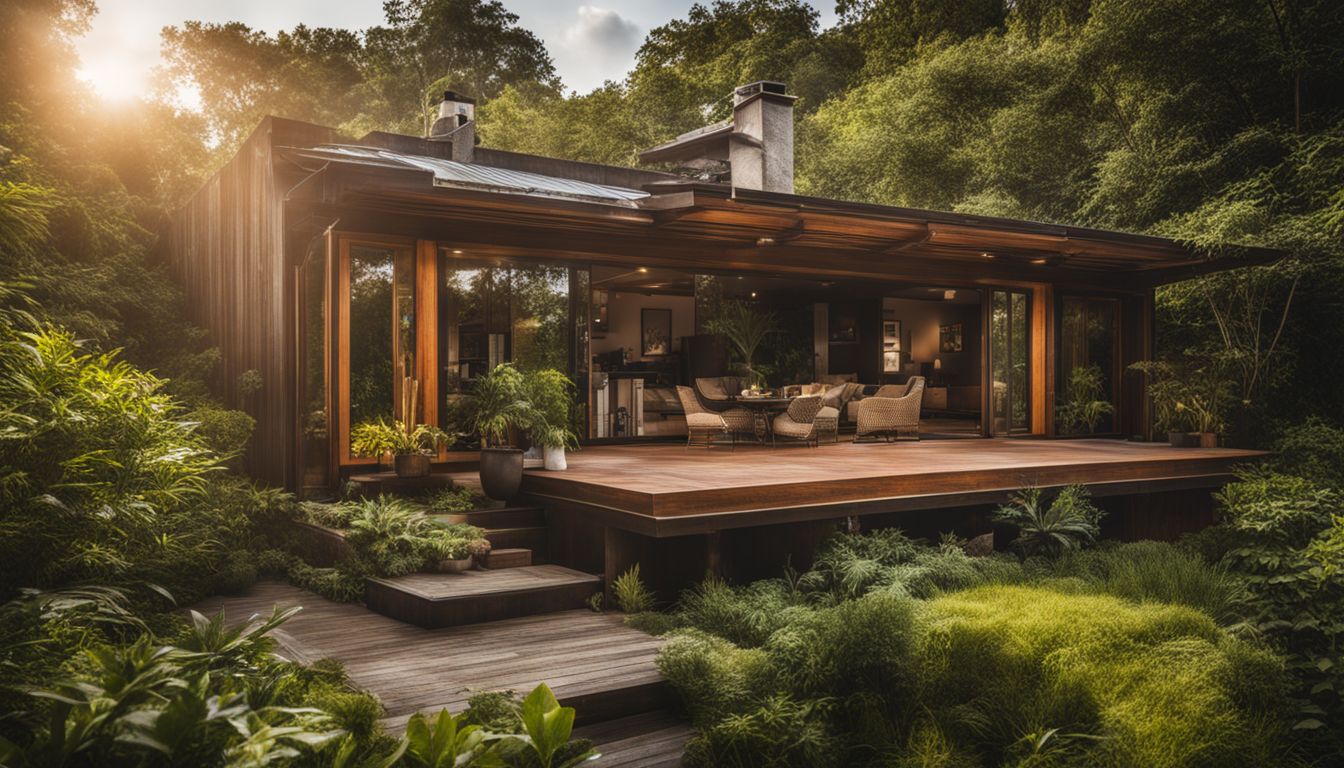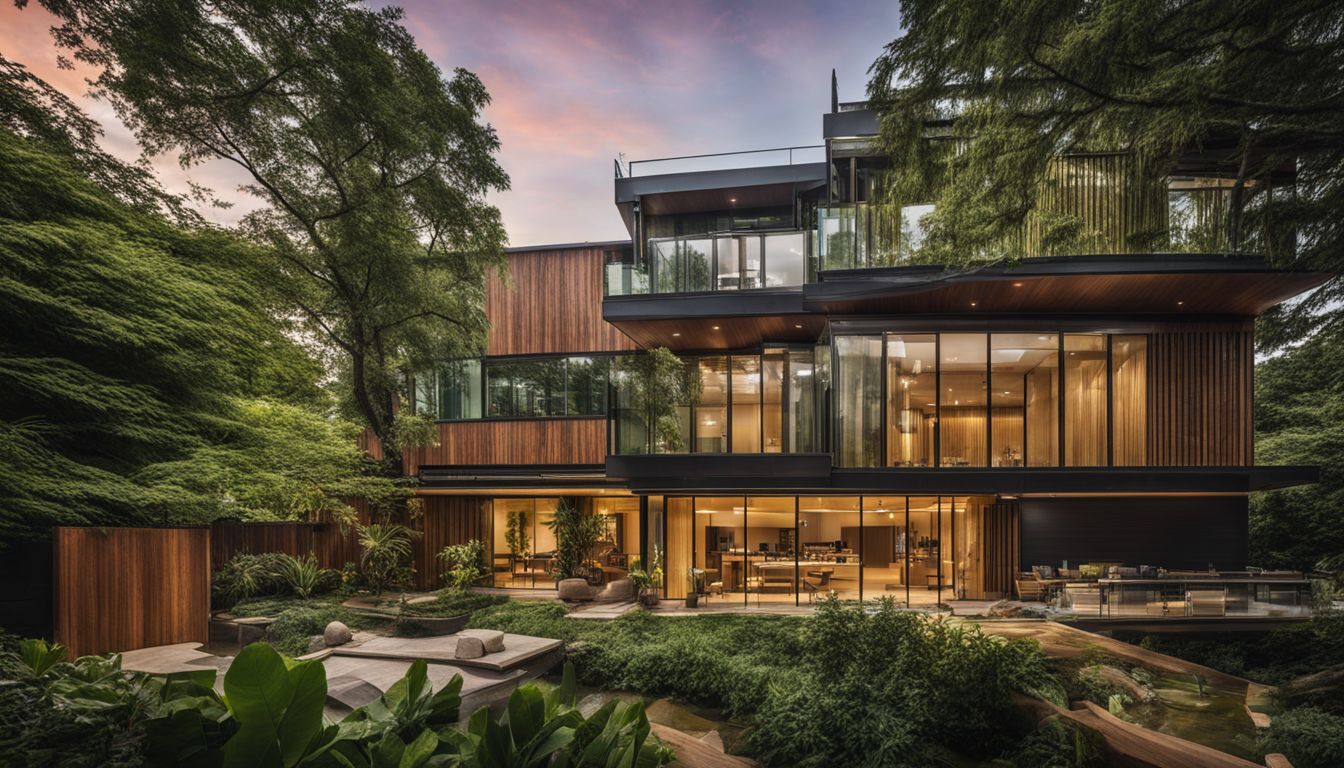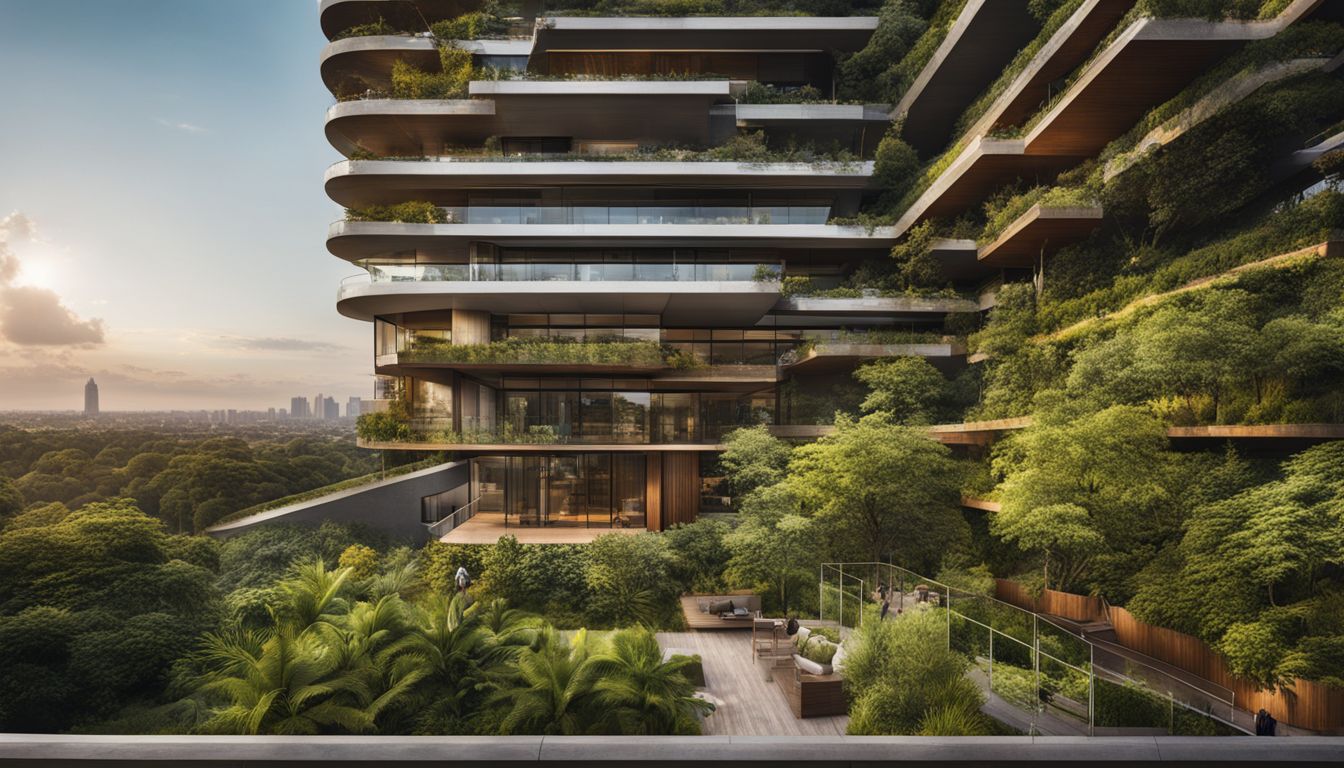
By: GreenFrontier Dispatch
Top Eco-Friendly Building Materials for Houses: Sustainable Solutions
Building homes used to mean cutting down trees and using lots of water and energy. Now, we know that’s not good for the planet. This blog talks about how we can use different things to build houses without hurting the Earth.
Some materials are from plants or recycled stuff, which is better for everyone.
I’ve worked over 20 years making houses that don’t harm our world. With my background in architecture and green building, I’ve helped design over 100 eco-friendly homes. My work shows that you can make amazing spaces while keeping nature happy.
Keep reading to learn how building with care makes a big difference!
Key Takeaways
- Bamboo grows quickly and is a strong, flexible option for eco-friendly homes.
- Recycled plastic reduces the carbon footprint of buildings with its durability.
- Straw bales provide excellent insulation, helping to save on energy costs.
- Sheep’s wool is a natural insulator that can lower carbon emissions and reduce energy bills.
- Mycelium, a type of fungi, offers a water – resistant and fireproof material for sustainable building.
What is Sustainable Construction?

Moving from our introduction, sustainable construction stands as a powerful approach to building that prioritizes the planet. This method focuses on using materials and processes that are environmentally friendly and resource-efficient.
It’s all about making smart choices—selecting supplies that don’t harm the earth and designing buildings that use less energy.
Sustainable construction works towards cutting down carbon emissions and reducing energy consumption. Materials like bamboo, recycled steel, and straw bales play a big role here. They are not just strong but also kind to our environment because they come from renewable sources or are made of waste products.
This way of building supports not only saving money on energy bills but also helps in fighting global climate change. Each choice made in this type of construction aims at improving the health of our planet while creating spaces where people can live better lives.
Benefits of Sustainable Construction

Sustainable construction promotes healthier living by using materials that reduce harmful emissions and create a more natural indoor environment. It also cuts down on waste, saving resources while boosting the economy through innovation and demand for eco-friendly products.
Promotes Healthier Living
Eco-friendly homes are good for you. They use materials like bamboo, recycled plastic, and straw bales that keep your living space clean and nontoxic. These natural building blocks improve air quality inside your home.
Better air means fewer health problems like asthma or allergies.
Green homes lead to happier, healthier lives.
Living in a house built with sustainable construction materials also reduces energy bills. This is because materials such as plant-based polyurethane rigid foam and sheep’s wool provide great insulation.
Keeping houses warm in winter and cool in summer without using too much energy makes life more comfortable and saves money.
Reduces Waste
Using sustainable building materials like bamboo, recycled steel, and reclaimed wood cuts down on waste. These materials come from sources that are either naturally renewable or saved from landfills.
For instance, recycled steel is the most reused material across the globe, making it a top pick for eco-friendly construction projects. This choice helps lessen trash linked with creating new building supplies.
Choosing bamboo not only supports green construction but also takes advantage of its quick growth rate and compostable nature, minimizing leftovers in the building trade. With these methods, construction sites become part of the solution to waste problems instead of adding to them.
Every material selected for its sustainability means less rubbish ending up in our environment, promoting cleaner building practices.
Boosts the Economy
Sustainable construction boosts the economy by creating job opportunities and driving innovation in eco-friendly building materials. This stimulates economic growth while promoting environmental conservation.
The use of sustainable materials reduces overall expenses, leading to long-term savings for homeowners and businesses. Additionally, investing in green building materials contributes to a resilient economy by mitigating risks associated with climate change and supporting local industries.
Key Entities: sustainable construction, job opportunities, innovation, eco-friendly building materials, economic growth, environmental conservation, sustainable materials, expenses reduction
Promotes Sustainability
Sustainable construction promotes a healthier environment and reduces waste. It also boosts the economy while promoting cleaner living. Using eco-friendly building materials can significantly reduce energy consumption, lower carbon emissions, and mitigate the effects of climate change.
This leads to potentially reduced home insurance costs and supports a more sustainable lifestyle.
By embracing sustainable architecture, we can contribute to a greener planet while improving our quality of life. Additionally, using recycled or natural materials in construction helps in lowering energy bills and reducing environmental impact.
Top Eco-Friendly Building Materials
Explore sustainable construction with these top eco-friendly building materials, including bamboo, recycled plastic, and mycelium. Create healthier living spaces while reducing waste and boosting the economy with these durable options for home construction.
Bamboo
Bamboo is a key sustainable building material, favored for its strength and flexibility. This fast-growing plant is versatile and can be used for various construction purposes. It’s entirely biodegradable and antibacterial – perfect for eco-friendly homes! Using bamboo in construction reduces carbon emissions, lowers energy consumption, and promotes sustainability.
Its rapid growth cycle and renewability make it an excellent choice for green building, leading to lower environmental impact while offering durability.
Bamboo’s quick growth makes it a top sustainable alternative with myriad applications in eco-friendly home construction.
Cob
Cob, an eco-friendly building material, is made from subsoil, water, and fibrous organic materials like straw or lime. It has natural insulation properties that allow cob houses to require minimal or no heating.
This ancient construction method dates back over 10,000 years and offers a sustainable solution for alternative house design lovers seeking environmentally friendly options.
Moving on to the next section about “Recycled Plastic.”
Recycled Plastic
Recycled plastic offers an eco-friendly alternative for building materials. Its carbon-neutral, non-toxic production process minimizes environmental impact, aligning with sustainable construction values.
This versatile material also boasts superior durability and sound-retaining properties—ideal for constructing energy-efficient and environmentally conscious homes. Its impressive 95% lower greenhouse gas emissions compared to concrete blocks make it a major player in reducing the carbon footprint of building projects.
Incorporating recycled plastic into construction not only promotes sustainability but also showcases innovation in eco-friendly design.
Straw Bales
Straw bales, 100% recyclable and biodegradable, are sourced from renewable materials and used for insulation in homes. They form tiny air pockets that trap air effectively, providing energy-saving insulation.
These bales can be compressed into panels for insulated cladding, leading to lower carbon emissions and reduced energy bills. Embracing straw bale insulation is a sustainable choice that offers both environmental benefits and economic savings for eco-friendly house design.
…
This content includes entities from the “Concepts” category relevant to the topic “- Straw Bales”, such as sustainable construction, insulation, eco-friendly building materials, renewable materials, and energy savings.
Recycled Steel
Recycled steel is incredibly strong and durable, making it an excellent choice for sustainable construction. It’s the most recycled material worldwide, which significantly reduces its environmental impact.
Using recycled steel in building applications lowers the carbon footprint of projects, supporting eco-friendly practices. In fact, recycled steel can match new steel in quality while lessening the strain on natural resources and energy consumption.
Innovative Solutions – Newspaper Wood
Sheep’s Wool
Sheep’s wool, a natural insulator, forms millions of tiny air pockets that trap air; it’s easy to source and is an excellent energy-saving material. Using sheep’s wool as a building material can lead to lower carbon emissions and energy savings, resulting in reduced energy bills.
Associated with top eco-friendly building materials for houses due to its natural insulation properties and sustainability, it is highly renewable and resilient with moisture-resistant properties.
Ideal for ceiling panels, acoustic walls, and flooring.
Cork
Cork is a lightweight and renewable material, renowned for its resilience and moisture resistance. It has excellent insulating properties, making it ideal for flooring, acoustic walls, and ceiling panels in eco-friendly construction.
This recyclable material possesses fire-retardant features and helps to prevent mold growth, marking it as an excellent choice for sustainable building projects. Cork oak trees mainly grow in Portugal where nearly 60% of cork production originates from; however, the material’s popularity is also increasing in the U.S., further underscoring its global appeal.
Next up – Plant-Based Polyurethane Rigid Foam!
Plant-Based Polyurethane Rigid Foam
Moving on from cork, another noteworthy eco-friendly building material worth considering for alternative house designs is plant-based polyurethane rigid foam. Made from natural materials such as hemp, kelp, and bamboo, this innovative insulation solution offers numerous benefits for sustainable construction.
It excels at protecting against mold and pests, provides sound insulation that enhances comfort within homes and commercial buildings, and offers exceptional heat resistance. Due to its natural composition and versatile properties, plant-based polyurethane rigid foam stands out as a sustainable method for insulating houses while reducing the environmental impact of construction.
This material emerges as an essential component in the realm of sustainable architecture and construction due to its unique combination of renewable raw materials like hemp, kelp, and bamboo – all supporting a more environmentally friendly approach towards constructing homes.
Furthermore, it aids in reducing the carbon footprint involved in construction projects by offering efficient yet eco-friendly heating solutions that align with sustainability practices.
By incorporating plant-based polyurethane rigid foam into building structures and systems particularly designed to enhance energy efficiency while promoting healthier living conditions within homes.
Concepts: Sustainable Construction Materials
Mycelium
Mycelium, a fungus fiber, is used as an eco-friendly building material. It’s strong, water-resistant, and fireproof. Mycelium has the potential to revolutionize construction with its sustainability and versatility for home building.
This natural material means lighter environmental impact in a world where sustainable living matters more than ever.
Let’s now delve into some innovative sustainable building materials!
Recycled Glass
Recycled glass reduces carbon footprint in construction. It creates sustainable cement options and minimizes waste. Using recycled glass supports CO2 emission reduction to build more sustainably, but its low recycling rate contributes to environmental waste issues.
Incorporating recycled glass into construction materials can significantly reduce the overall carbon footprint of a project. This material offers an environmentally friendly and unique option while contributing positively to sustainability efforts by reducing CO2 emissions and supporting eco-friendly building practices.
Reclaimed Wood
Reclaimed wood offers a sustainable building material option for alternative house designs. Its use reduces the environmental impact of harvesting new timber, leading to lower carbon emissions and energy savings.
Additionally, it adds an aesthetic appeal to homes and contributes to overall well-being while promoting eco-friendly living spaces. Incorporating reclaimed wood into construction projects aligns with the principles of sustainable design, offering a tangible way for individuals to contribute to environmental conservation efforts.
Precast Concrete
Precast concrete is an eco-friendly building material used in sustainable construction. It’s manufactured off-site, reducing CO2 emissions and waste. This process ensures precise measurements, making it a top choice for alternative house design lovers seeking sustainable solutions.
The material promotes sustainability while decreasing its environmental impact, aligning with the ethos of eco-friendly living spaces.
By employing precast concrete in their designs, architects can advocate for environmentally responsible construction practices without compromising quality or aesthetics. Incorporating this material into new building projects supports the construction industry’s shift towards green materials and reduces overall carbon footprint.
Alternative house design enthusiasts looking to create homes that positively impact the planet should consider using precast concrete as one of their primary building materials.
Innovative Sustainable Building Materials
From pollution-absorbing bricks to 3D-printed concrete, innovative sustainable building materials are transforming the construction industry. These cutting-edge solutions promise eco-friendly alternatives that reduce environmental impact and enhance sustainable living.
Newspaper Wood
Newspaper Wood, a sustainable and innovative building material, is crafted by compressing old newspapers and glue into a wood grain texture. This process upcycles recyclable waste, providing new life to old newspapers which contributes to environmental sustainability.
When considering eco-friendly building materials for alternative house designs, Newspaper Wood presents an opportunity to embrace creativity while reducing environmental impact.
This innovative material is especially relevant for those looking towards eco-friendly construction solutions that prioritize sustainability and resource efficiency in their building projects.
Pollution-Absorbing Brick
Pollution-absorbing brick is a revolutionary eco-friendly material designed to trap air pollutants and enhance air quality. Its unique composition, including a special coating of titanium dioxide, triggers a reaction with sunlight to dismantle harmful pollutants in the surrounding air.
By integrating pollution-absorbing bricks into construction projects, it’s possible to actively reduce urban air pollution and contribute to healthier, more sustainable living spaces.
This innovative building material holds great promise as part of an environmentally friendly approach to construction.
3D-Printed Concrete
3D-printed concrete is an innovative sustainable building material that’s revolutionizing construction. It reduces energy consumption and carbon emissions, making it an eco-friendly choice for alternative house design lovers.
Incorporating 3D-printed concrete into sustainable architecture aligns with the goal of creating homes that positively impact the planet.
The use of 3D-printed concrete underscores a commitment to environmentally conscious building practices while embracing cutting-edge technology in construction. Its application represents a significant step towards minimizing the environmental impact of new construction projects, offering a promising solution for those seeking to build their homes with sustainability at the forefront.
Recycled Tires
Recycled tires are transformed into innovative sustainable building materials, perfect for eco-friendly homes. These materials provide an alternative to traditional carbon-emitting options and offer solutions for reducing waste.
Recycled tire products can be used in construction to create durable and environmentally friendly building components, making them a valuable addition to the realm of sustainable housing options.
Their impact on the environment is significant as they help reduce CO2 emissions while also repurposing large quantities of discarded tires.
Innovative sustainable building materials like recycled tires demonstrate a commitment towards thoughtful construction practices that prioritize environmental responsibility and resource conservation.
They offer unique opportunities for creating bespoke homes tailored towards sustainability, showcasing a dedication to ever-evolving eco-conscious design.
Conclusion
In conclusion, the eco-friendly building materials we’ve explored offer sustainable solutions for alternative house design lovers. From bamboo to recycled steel and innovative options like mushroom-based building techniques, there are numerous choices to consider.
These materials not only promote healthier living but also reduce waste, boost the economy, and support sustainability. By incorporating these environmentally friendly options into construction, we can create homes that positively impact the planet while embracing cutting-edge design technology.
Let’s explore and implement these top eco-friendly building materials in our quest for sustainable living!
FAQs
1. What makes a building material eco-friendly?
Eco-friendly building materials are those that reduce harm to the environment, either by cutting down on carbon dioxide emissions during production or being made from recycled materials. They’re key players in sustainable construction today.
2. Can you name some top sustainable building materials for homes?
Absolutely! Some of the best include rammed earth, straw bale construction, and mushroom-based building products. These materials are not just good for the planet; they’re also fantastic insulators for homes.
3. How does using recycled materials in construction help the environment?
Using recycled building materials helps big time because it cuts down on waste. Instead of ending up in landfills, things like recycle plastic get a new life as part of your home—talk about a win-win!
4. Why is rammed earth considered an eco-friendly option?
Rammed earth is one of those superstar eco-friendly options because it uses natural resources without depleting them. Plus, buildings made from rammed earth stay cool in summer and warm in winter, which means less energy used for heating and cooling.
5. Are there any innovative eco-friendly construction techniques I should know about?
You bet! Techniques like straw bale construction aren’t just quaint—they offer serious insulation benefits and use renewable resources efficiently. Then there’s Earthship homes—a method known for making houses almost entirely out of recycled materials.
6. How do sustainable building products impact overall construction costs?
Initially, you might think going green costs more—and sometimes it can—but these materials often save money in the long run through lower utility bills thanks to better insulation properties and durability compared to traditional options.